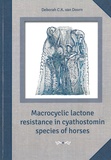Macrocyclic lactone resistance in cyathostomin species of horses

Doorn, Deborah van
- Promoter:
- Prof.dr. J.A. (Jaap) Wagenaar
- Co-promoter:
- Dr. H.W. (Harm) Ploeger & dr. F.N.J. (Frans) Kooyman
- Research group:
- Wagenaar
- Date:
- May 27, 2014
- Time:
- 12:45 h
Summary
Cyathostomins are the primary helminths pathogens of young (1-3 years) horses. Worldwide anthelmintic resistance development of cyathostomins against several anthelmintic drug classes has been shown. Since macrocyclic lactones (MLs) is the last group that was introduced the aim of the first study was to look for ivermectin (IVM) resistance on Dutch horse premises using the fecal egg count reduction test (FECRT). Seventy premises were investigated through pooled fecal samples and larval cultures. Questionnaire data showed that 34 percent of the 70 participants frequently dewormed within the egg reappearance period (ERP). None of them tried to use pasture rotation as worm control measure. Fecal examination before deworming was only done on 2 farms. Only in one horse an efficacy of IVM against cyathostomins of less than 95% was found. To further study ML resistance development with FECRT and shortening of the ERP premises in Italy, Belgium and the Netherlands were selected. Animals were allocated to the IVM or moxidectin (MOX) treatment group. In total, 320 horses on 32 premises were examined. In the Netherlands the FECRT 14 days after treatment indicated a 92% efficacy on one farm and shortening of ERP on 6 premises. To investigate the species that contributed to a shortened ERP, 4 Dutch horse premises were selected. Fecal samples from 21 horses, before and after ML treatment, were cultured and 40 larvae obtained from each culture were individually differentiated. This showed that early egg shedding was dominated by species of the genus Cylicocyclus. Before treatment species composition was generally more diverse with species from several other genera present. In the Netherlands in 2008 regulatory changes were made which made anthelmintics prescription only medicines (POM). Questionnaire surveys to study changes in horse practitioners’ practices at the beginning of POM and again 4 years later were performed. Results showed that in 2012 significantly more fecal samples were examined than in 2008, more were taken for monitoring purposes, more were examined quantitatively and more use was made of pooled fecal samples. In the 1st in vitro study larvae from a never treated and from a regularly ML treated population were in vitro selected using a reiterative Larval Migration Inhibition Assay (rLMIA) and were differentiated to species. In both larval cultures the predominant species were Cyathostomum catinatum, Cylicocyclus nassatus and Cylicostephanus longibursatus. After in vitro selection the predominant species became Cya. catinatum in both cultures, while Cyc. nassatus disappeared in the never treated but not in the regularly ML exposed population. In the 2nd in vitro study a two-sieve rLMIA was performed to study the intra-specific variation in IVM susceptibility using 8 worm populations with different histories of ML exposure. In all 8 populations the pre-dominant species were Cya. catinatum, Cyc. nassatus, Cys. longibursatus and Cya. pateratum. After in vitro separation of larvae in the presence of IVM the most prevalent species became Cya. catinatum and Cys. longibursatus. A higher migration percentage for the 2nd sieve was demonstrated, especially for Cya. catinatum, indicating selection of larvae with low IVM susceptibility. It was found that within cyathostomin species there is heterogeneity with respect to in vitro IVM susceptibility.